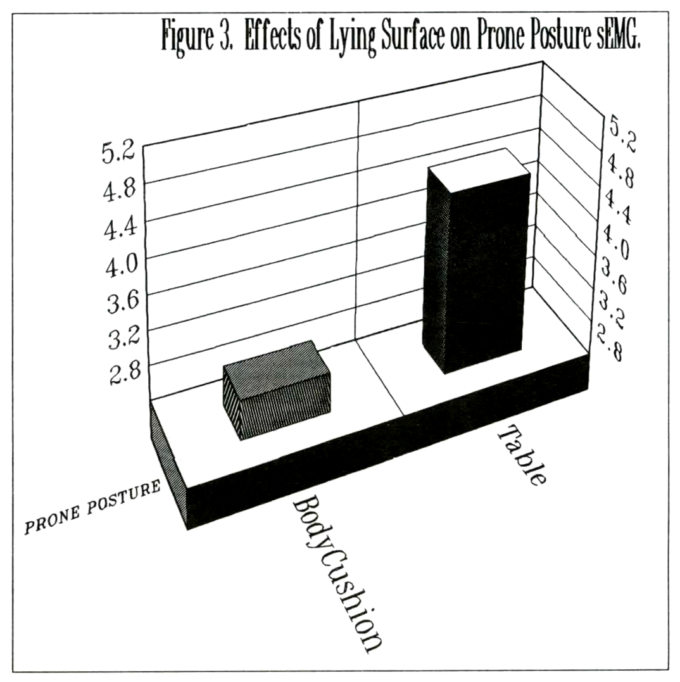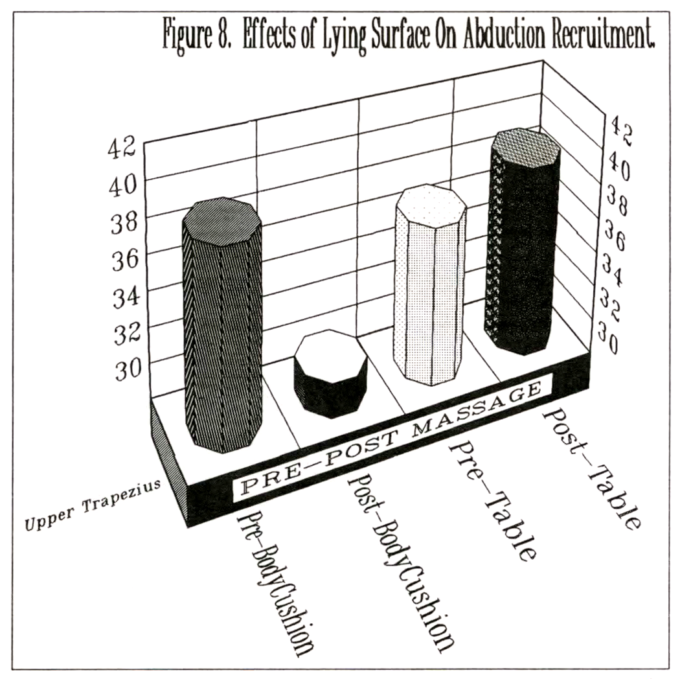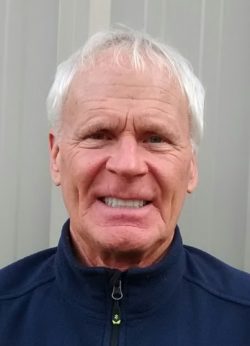Journal of Massage Science, 2016, #4
ROLE OF BODY ERGONOMICS IN STRESS REDUCTION MASSAGE - ROLE OF bodyCushion™
For a while, the Journal of Massage Science did not have an interesting article for the Science of Therapeutic and Stress Reduction Massage section. Journal of Massage Science thinks that this article is very informative and important for therapists who practice stress reduction massage. This information will greatly contribute to the nation’s health.
The goal of any massage session is to reduce levels of stress and balance activity of sympathetic and parasympathetic nervous systems. Therapists that go the extra mile, to provide the best service, take continuing education classes, design therapy rooms, play soft music, etc. However, one critical component is frequently missed; the client’s positioning on the table and table support.
As you will read below, just placing the client in an ergonomic position, while gravitational and biomechanical forces cancel each other, gives the therapist a great advantage during the therapeutic session. Thus, the application of correctly formulated massage protocol which follows becomes even more efficient. As our readers know we are not in business of advertising but we think that therapists should consider the bodyCushion™ as an important tool for enhancing their therapy.
Dr. Ross Turchaninov.
Editor in Chief
ROLE OF BODY ERGONOMIC IN STRESS REDUCTION MASSAGE.
ROLE OF the bodyCushion™
By Tom Owens, LMT
Does client comfort affect the outcome of a massage treatment? To what extent does client comfort affect the client’s experience of receiving treatment? What is client comfort? How is optimal client comfort achieved?
The answers to these questions, it requires a small crash course in the effect of massage therapy on the function of the autonomic nervous system. According to a world recognized theory proposed by Professor H. Selye (1955), the chronic accumulation of stress is the first stepping stone in the development of all chronic pathologies in the human body; exceptions include trauma, infection, or genetic predisposition.
The main functions of our body are beyond our conscious control, since they are under the control of our autonomic nervous system, which has two divisions: sympathetic and parasympathetic. While the sympathetic division, or “fight and flight” division of the autonomic nervous system is more active during the day, its parasympathetic division, or “rest and digest division,” is more active at night. The healthy body interaction of both divisions should equal zero, since they are constantly watching each other, trying to self-adjust their activity and subsequently balance (Barr, J .S., Taslitz, N 1970).
The daily events of our performance-demanding lives constantly drive up sympathetic tone. As this builds up from day to day, month to month, a gap between both systems can become so large that it triggers varieties of somatic and visceral problems.
The main goal of massage therapy, as a preventive measure, is to decrease the sympathetic tone to equalize activity of both systems and to maintain the client’s overall health (Barr & Taslitz, 1970; Longworth, 1982). Therapists try to reinforce this effect of massage therapy by playing music in the background, dimming lights, etc. I am sure that any additional tool (e.g., aromatherapy) which helps diminish sympathetic tone should be welcomed by therapists.
From this perspective, optimal support of the client’s body on the massage table is a frequently overlooked subject, whom I think must be considered by therapists who want to optimize the stress reducing effect of each massage session, help their clients, and build their own practices.
DEVELOPING THE CONCEPT OF THE bodyCushion™
From a young age, I experienced a great deal of pain and tension in my neck and shoulders. I also noticed that different body positions reduced the intensity of my symptoms. In 1970, my girlfriend gave me my first full-body massage; The massage techniques she used were varied and amazing! I marveled that such a simple act, as applying hands to a person’s body, could bring so much relief and be so rejuvenating.
In 1974, I built my first massage table in a woodshop class. The table had a beautiful inlaid birch wood top that I didn’t want to cover with foam and vinyl. So I covered it with two sheets of one-inch foam with terry cloth material. Looking back, it is difficult to imagine that I massaged my subjects on this table. There was no accommodation for the face, and no support for the head when the subject was face-down.
Sometime about 1983, I went to receive a massage. The decor of the therapist’s massage room was lovely; the color of the walls, the furnishings, the artwork. The therapist had me lie face down. She burned sweet grass as she covered me.
She said, “There you go,” then she asked me a question, “Are you comfortable?”
I lied. I lay there, face squished in a slot, thinking, “This sucks! I don’t think anyone is going to do anything about the discomfort of being on a massage table.” I continued to think, “Really? This is the way it is, and we just accept that this is the way it is?”
I vowed to myself I would solve this puzzle.
For two years I struggled with the challenge of designing a table that would afford comfort to clients. After two years of trial and error, I created a stationary table with a rising upper-body half, an adjustable face rest, an adjustable arm shelf that could be moved up or down. and was removable. This table cost me about $2,200 to build; I proudly transported it to a hospital physical therapy clinic to do an in-service manual training.
This table did afford more comfort than a typical flat table, but I was soon challenged to provide comfort for a client with breast augmentations. She had been in an automobile accident and had been referred to my practice to be treated for whiplash. To make her comfortable, I started to use sheets of foam of different densities, layered and built up to support on her bony structures. This worked! She reported complete comfort and was able to relax during prone treatment. No guarding, and no protective muscle tension!
After about a month, I realized that I could devise a similar support for the pelvis allowing ventral space for the abdominal organs, bladder and male genitalia. I also realized that this approach allowed a distinct relief and decompression of my own lumbar spine.
Soon my clients started to give me rave reviews and it encouraged me to use the device more and more. I began to realize that because my clients were so relaxed, my work became easier and more beneficial for them. Muscle groups were more easily palpated; mobilizations and stretches were supported and more easily achieved. My simple device works as a neutralizer of gravity and biomechanical forces, which normally elicited pressure on the body flatly positioned on the table.
My device I had contrived became so popular I spent a considerable amount of time cutting foam sheets with an electric turkey knife and sewing vinyl coverings on a borrowed sewing machine. This took place in the kitchen of my tiny cottage in Ashland, Oregon; the place in which I practiced massage.
I finally, simply, named it, “bodyCushion™.” Generally speaking, the BodyCushion™ system consists of different size foam blocks with special openings. Placing these blocks under the client’s body allows the client to achieve the best ergonomic position during entire massage session.

Fig. 1. Side view of Body Cushion System placed on massage table and with client laying on the stomach.
SCIENTIFIC STUDY OF THE bodyCushion™
Since our device afforded such a marked improvement in anatomical support with resultant comfort for my clients, I embraced a mission of challenging the status quo by educating about the importance of positioning. I started sharing the profound improvements in the treatment outcomes. To do so, I decided to participate in an American Back Society meeting in San Francisco, demonstrating the bodyCushion™ in an exhibit booth. Across the aisle was a company that advertised a device which tests muscle tension using Electromyography (EMG). After some time of watching me and others demonstrating in our booth, Dr. Vinitsky from the EMG booth came over to discuss the possibility of doing an EMG study with the bodyCushion™, comparing the positioning effects produced by a regular massage table vesus the effects produced by the bodyCushion™ placed on top of massage table.
We agreed to engage in a study with the intentions of its results being published in medical journals. After the formal agreement was prepared and signed by each party, the study went underway. After some two weeks had passed, I got a call from Dr. Vinitsky:
“Hello, Tom. I have some very exciting news for you!”
“Oh, is the study finished already?” I asked with surprise.
“Oh, no, no, Tom. We’re just beginning the first phase of the study. We are testing the subjects for muscle tension while seated, standing, and then we test them lying on the regular massage table. What we’re finding is that when we test the subjects who are on the regular massage table, the tension levels are going up!”
Dr. Vinitsky continued, “I had assumed that because they are lying down, the tension would go somewhat down, but that’s not the case. The tension is increasing while lying on the flat table. At first, we thought maybe something wasn’t right with our testing, or the device itself, so we tested again. Sure enough, the tension rises on the flat table! I just had to call you to let you know. I’m going to continue this phase of the study and I call you next week with more findings.”
About a week later, Dr. Vinitsky called again, “Tom, more news! Now we’re finding that the longer the subjects are on the flat table, the higher readings of muscle tension! We now know that the tension increases the longer your clients lie on the flat table!”
The EMG study, authored by Dr. Jeffrey R. Cram and Dr. Itamar Vinitzky was published in October 1994, in the Journal of Myofascial Therapy. The study compared EMG readings as a result of brief massages given to two groups of subjects. Both groups were positioned prone, but on different surfaces. Subjects from one group laid on a flat massage table and subjects from another group laid on a massage table with a bodyCushion™.
The study found that massages given to subjects lying on the bodyCushion™ placed on top of massage table produced lower levels of Resting, client is on the table, and Dynamic, after massage session was over, EMG activity, compared to subjects who received a massage on a standard massage table (Cram & Vinitzky 1994). Fig. 2 illustrates levels of resting muscle tension in the clients who were positioned on the table with bodyCushion™ system placed on top of it, and those on the regular massage table.

Fig. 2. Level of EMG activity in the muscles of clients with and without ergonomic support (Cram & Vinitzky 1994).
“The differences in the EMG levels reflect the different ergonomic effects of the bodyCushion™ versus the standard massage table. The bodyCushion™ seems to better facilitate normalized gamma motor, and therefore muscle function, thus providing better support to the shoulder and upper back than the standard massage table” (Cram & Vinitzky 1994).
The profound effects of bodyCushion™ on the muscle tension is a result of ergonomic support itself, and as a benefit this support, decreases the levels of sympathetic activity.
Another find, which was reported in the article, was presence of significant “asymmetrical EMG recordings” in those clients who were prone on the regular massage table. Meaning that positioning on the regular table without ergonomic support creates a disbalance between various muscle groups, and they start to exhibit different levels of muscle tension while the client supposed to be “completely relaxed.” This fact, to a significant degree, ruins the therapists’ efforts of reducing muscle tension and balancing interaction between muscle groups. As soon as clients were placed on the bodyCushion™, entire Resting Muscle EMG activity synchronized (Cram & Vinitzky 1994).
“There is a gentle art to the use of pillows and cushions during massage procedure. These biomechanical aids support the body while it lies prone on an otherwise flat surface. This appears to help ‘relax’ muscles” (Cram & Vinitzky 1994).
Finally, the completely unexpected find was the detection of dynamic activity in the muscles after the session in clients who were massaged with and without ergonomic support. Fig. 3 illustrates this find. On the left side of the graph, you see levels of Dynamic EMG in the trapezius muscle before and after massage performed on the BodyCushion placed on the massage table (Cram & Vinitzky 1994). The right side of the graph illustrates the level of Dynamic EMG in the trapezius muscle before and after massage session conducted on the regular massage table.

Fig. 3. Results of Dynamic EMG recorded in the upper trapezius after being on the BodyCushion and regular massage table (Cram & Vinitzky 1994).
This amazing data indicates that desynchronization of the muscle activity while the client is positioned on the table without ergonomic support increases level of the dynamic EMG after the session is over. Thus, instead of completely decreasing muscle activity and balancing both divisions of the autonomic nervous system, the lack of ergonomic support during the treatment did not trigger complete muscle relaxation; despite of the correct efforts by the therapist.
“The main finding of this study is that massages using a body support system for subjects yielded lower levels of EMG activation post-massage than the same treatment on a standard massage table” (Cram & Vinitzky 1994).
The study’s results proved that ergonomic support offered to head, shoulders, rib cage, lower spine and pelvis is a critical component of a therapeutic massage session. Usage of the bodyCushion™ allows achievement of a baseline effect of muscle relaxation and it multiplies by several times the outcome of treatment conducted by therapists, helping you to build up a healthy and thriving practice.
We follow all products which are offered in the industry, and we can guarantee that the bodyCushion™ effectively reduces the client’s muscle tension simply being positioned on its ergonomic surface. The important effect of our product is supported by hard scientific data. “When a massage practitioner uses proper ergonomic support for his prone-lying client, he way more effectively reduces and normalizes the client’s muscle activity in the neck, shoulder, and upper back regions” (Cram & Vinitzky 1994).
The EMG results very apparently mimicked what I, and others, have been feeling in our bodies every time we had a massage on a flat table. We simply accepted this discomfort as part of receiving a massage treatment! Evidently and unreasonably it is thought that this is just the way it is. Now, we have proof that it doesn’t need to be any longer!
REFERENCES
Barr, J .S., Taslitz, N (1970). The Influence of Back Massage on Autonomic Functions of Physical Therapy, Retrieved from pages 1679-1691.
Cram, J. R., Vinitzky, I (Oct 1994). Massage: A Surface EMG Comparison of the Effects of a Body Support system Versus a Standard Massage Table. Retrieved from The Journal of Myofascial Therapy, McDowell Publishing Company, Vol. 1, No. 3. Rpt.
Longworth, J.C.D.(July, 1982). Psychophysiological effects of Slow Stroke Massage in Norrnotensive Females. Retrieved from Advanced in Nursing Science, July Issue, pages 44-61, 1982.
Selye, H (1955). Stress and Disease. Retrieved from Science, Issue 122: pages 625–631.
WHO IS TOM OWENS

Tom Owens, founder of Body Support Systems, has been engaged in the pursuit of therapeutic orthopedic positioning for more than 30 years. Having explored, examined, researched, and tested various aspects of positioning as a singular career pursuit since 1984, it has been said that no one knows more about orthopedic positioning. Tom was licensed as a Massage Therapist in 1985. More information about Tom and his work can be found at: https://bodysupport.com
Science of Massage Institute, Journal of Massage Science, 2016, #4
